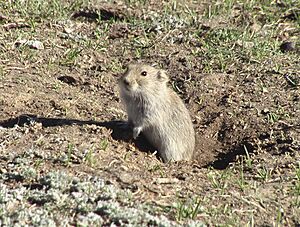Brandt's vole facts for kids
Quick facts for kids Brandt's Vole |
|
|---|---|
 |
|
| Conservation status | |
| Scientific classification | |
| Genus: |
Lasiopodomys
|
| Species: |
brandtii
|
| Synonyms | |
|
L. aga (Kastschenko, 1912) |
|
The Brandt's vole, also called the steppe vole, is a small furry animal. Its scientific name is Lasiopodomys brandtii. This rodent belongs to the Cricetidae family, which includes hamsters and other voles. You can find these voles living in shrublands and grasslands in countries like Russia, Mongolia, and northern China.
Contents
What Does a Brandt's Vole Look Like?
A Brandt's vole is about 15 cm (5.9 in) long, which is roughly the length of a pencil. Its tail is shorter, usually up to 3.5 cm (1.4 in) long. These voles have small ears. Their fur is a sandy-brown color all over, but it's a bit lighter on their belly. Their tail is completely brown, and they have thick hair on their back feet.
Where Do Brandt's Voles Live?
Brandt's voles are found in several places in Asia. They live in Nei Mongol, Jilin, and Hebei provinces in north-east China. You can also find them in Mongolia and the southern part of Transbaikalia in Russia.
Their favorite habitat is dry steppes and pastures, which are like large grassy plains. Sometimes, they also live in meadows near lakes or in river valleys.
How Do Brandt's Voles Live?
Brandt's voles are very social animals. They live in colonies, which means many families live together. Each family builds a complex network of burrows underground. These burrows have many entrances, long tunnels, special rooms for storing food, and cozy chambers for nesting.
These voles are active both during the day and at night. Their behavior can change depending on the time of year. They eat both the parts of plants that grow above ground and the roots underground. Before winter, they gather and store a lot of food. It seems like the amount of energy they get from food changes with how long the days are.
Female voles can have four or five litters of babies each year. Each litter usually has about seven young voles. The number of voles in a population can change a lot. Sometimes, if conditions are bad, they might disappear from some areas. But when conditions are good, their numbers can grow very quickly!
Staying Warm in the Cold
Brandt's voles are very good at dealing with cold weather. When it gets chilly, their bodies work harder to stay warm. They have a special kind of fat called brown fat. This brown fat helps them create heat without shivering. It's like their body has a built-in heater!
To keep warm, they also eat more food, especially in colder months. Even though they eat a lot, they use so much energy to stay warm that they sometimes weigh less in the summer than in the winter.


